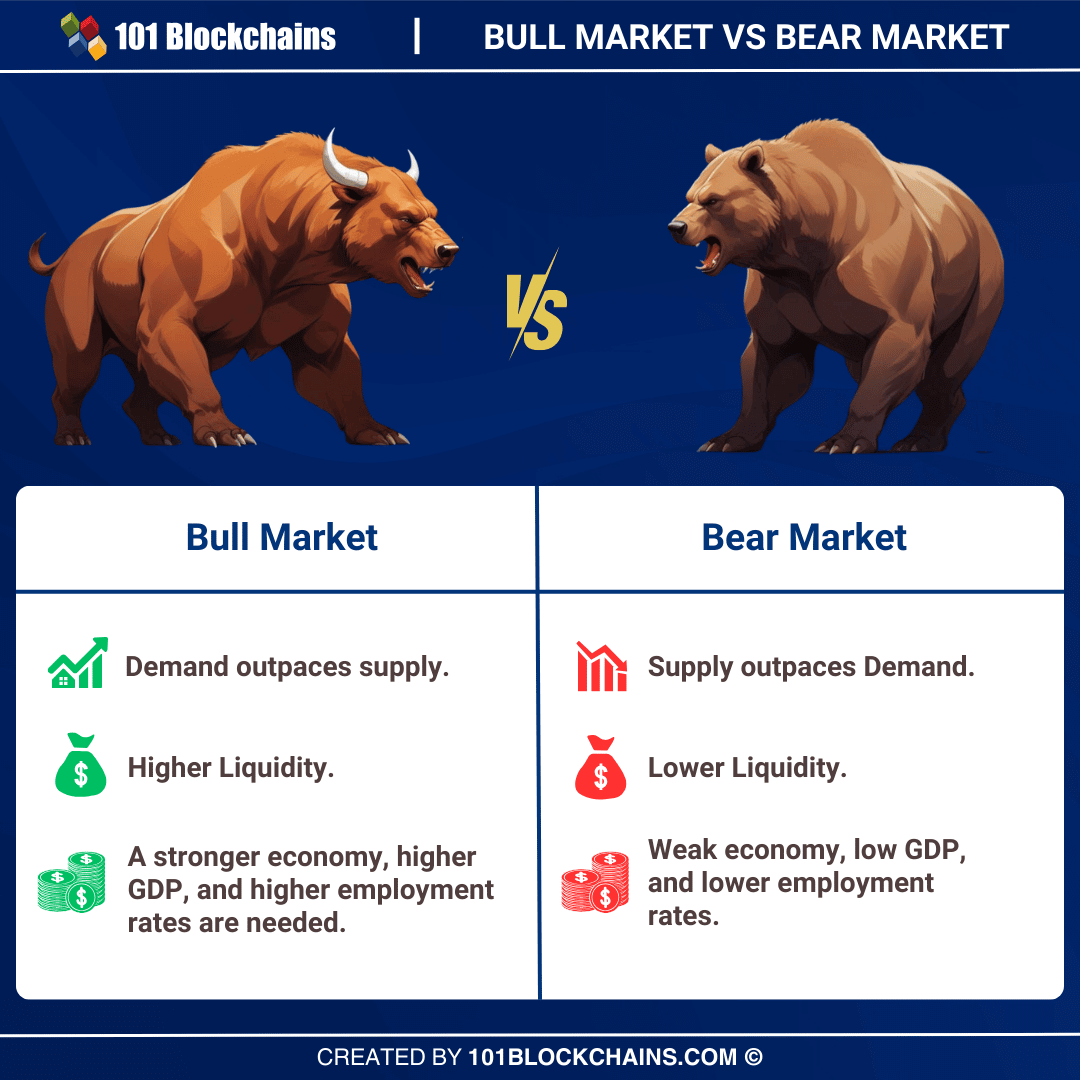Bull Market vs Bear Market: Key Differences

Understanding the financial markets will help you become familiar with terms like bull market and bear market. What are the animals doing in the financial services sector? Interestingly, the terms bull market and bear market have effectively transitioned from traditional financial services to the crypto sector.
Comparing bull and bear markets in cryptocurrencies can help you understand the crypto market better. Terms like bull and bear markets describe the performance of the stock market based on whether the value is increasing or decreasing. For example, a falling market can be called a bear market, while an increasing market can be called a bull market.
The cryptocurrency market is quite volatile and changes frequently during the day. Therefore, the difference between a bullish and bearish market helps to define the long-term movement of the market, both up and down. The corrections that help to classify the cryptocurrency market as a bullish and bearish market are usually significant and can range up to 20% in either direction. Let’s uncover the difference between a bullish and bearish market in the cryptocurrency space.
Embrace the technological leaps and global adoption expected in the upcoming bull market of 2024-2025 with the Crypto Bull Run Ready Career Path.
Defining a Bull Market in Cryptocurrencies
A bull market is generally focused on favorable economic conditions. This suggests that the market is growing and is accompanied by positive investor sentiment towards the cryptocurrency market. Another important characteristic of a bull market is the continued growth of asset prices, along with increasing employment levels and a strengthening economy.
The difference between bull and bear markets in the cryptocurrency space can be seen by understanding how bull markets work in crypto. Interestingly, the cryptocurrency market is more consistent and strong in bull markets. In most cases, a bull market can be triggered when the price of a cryptocurrency asset rises by 40% in one or two days. The cryptocurrency market is smaller and more volatile than traditional financial markets.
In all markets, bullish sentiment shows optimism about the continued growth of asset values. The same can be expected in the crypto space, as favorable economic conditions lead to the growth of cryptocurrencies. As a result, investors are looking for opportunities to leverage their ever-expanding cryptocurrency portfolios.
Build your identity as a certified blockchain professional and gain better career prospects with a blockchain certification from 101 Blockchains!
How to identify a cryptocurrency bull market?
Identifying a bull market in the cryptocurrency industry focuses on identifying various signals, such as actual indicators and trading signals. You can recognize pointers that distinguish bull and bear markets by reviewing the history of bear markets and bull markets. First, you should notice that stock prices are rising during a bull market in the cryptocurrency market. You can identify a bull market yourself by monitoring the price movements of popular cryptocurrencies along with the performance of the general cryptocurrency market. For example, you can identify a bull market by seeing prices rising for several months or weeks.
The next important differentiating factor in comparing bear and bull markets is the increase in trading volume. A significant surge in trading activity can be a clear signal of a bull market rising. Additionally, you can also identify a bull market in the crypto space by staying up to date with the latest trends in the crypto industry. Positive news and sentiment in the market can improve investor confidence, leading to the formation of a bull market. Speaking of market sentiment, you can use specialized tools such as the Crypto Fear & Greed Index to gauge the level of optimism in the crypto market.
Most importantly, a comprehensive review of bear and bull market history can help identify bull markets. Past market trends show that bull markets occur in cycles. The average duration of a bull market should be determined and reviewed in relation to the current market conditions to anticipate the timing of the next bull market.
Learn the basics of cryptocurrencies, how they work, and what the future holds in our Cryptocurrency Fudamentals Ebook.
Definition of a bear market
A bear market is the opposite of a bull market and represents a decrease in the value of a cryptocurrency. You can identify a bear market by checking for a decrease in the value of a cryptocurrency. In a bear market, the value of a cryptocurrency can drop by at least 20% and continue to fall. The most famous example of a bull market in cryptocurrencies is the December 2017 cryptocurrency crash. The infamous Bitcoin crash saw the largest cryptocurrency plunge in a matter of days. With the downtrend of a bull market, investor confidence will decrease, reinforcing the bearish pattern.
You may wonder, “Why is it called a bear market?” and you may do so while trying to understand the reasons and factors that affect a bear market. The pattern of a bull market is similar to a bear’s fighting style. A bear market starts at the top and pushes down with all its might like a bear, seemingly grabbing its prey with its claws.
In a bear market, we see slow economic growth and rising unemployment. Bear market situations can be caused by geopolitical crises, natural disasters, market bubble bursts, and poor economic policies. Most importantly, in a bear market, investor optimism is limited due to negative sentiment.
Want to gain a deeper understanding of crypto fundamentals, trading and investment strategies? Enroll in our Crypto Fundamentals, Trading And Investing Course today.
How to identify a cryptocurrency bear market?
The process of recognizing a bear market in cryptocurrencies is very similar to the process of recognizing a bull market. You can identify the difference between a bull market and a bear market by checking various real-world signals and trading indicators. Just like a bull market, a bear market shows a similar trend, but has a downward pattern.
A bear market is a sustained decline in the performance of a cryptocurrency asset over a long period of time. If you notice a sudden and prolonged decline, it may be a bear market. In addition, signs of rising unemployment rates may indicate a decline in the broader financial markets.
The next important sign of a bear market is an exponential increase in market volatility. A sharp price drop in crypto assets, especially large companies, can indicate an imminent bear market. You should also evaluate key economic indicators to compare bull and bear markets. Key economic indicators to watch for when predicting a bear market include inflation and interest rates. It is also important to keep an eye on negative developments in the crypto space, such as security breaches or regulatory crackdowns.
Start learning about cryptocurrency today with the world’s first cryptocurrency technology path with high-quality resources tailored to industry experts!
What is the difference between a bull market and a bear market?
The comparison between bull and bear markets is mainly centered around the direction of the cryptocurrency price. However, there are certain factors that can be taken into account that can indicate the difference between a bull and bear market in cryptocurrencies. Here are some notable highlights that can be found in the comparison between bull and bear markets in the crypto space.
The demand for cryptocurrencies is strong in a bull market due to positive investor confidence. This can cause the price of crypto assets to rise as investors compete with each other to buy available crypto assets. On the other hand, people are more likely to sell crypto assets in a bear market. A bull market is usually characterized by a decline in the price of crypto assets as supply exceeds demand.
Another notable difference between bull and bear markets is liquidity. In a bull market, you will see higher liquidity because crypto assets can be traded with lower transaction fees. However, in a bear market for cryptocurrencies, liquidity is lower because there is a lack of confidence in the market situation.
The economic impact can be distinguished between bear markets and bull markets. In a bear market, we see a decline in GDP levels, while in a bull market, we see a potential increase in GDP. In a bull market, when GDP increases, corporate profits increase and employment prospects improve. This leads to better and more positive market sentiment.
On the other hand, if GDP levels fall, it will lead to recession and failure to meet revenue targets. This will in turn lead to negative market sentiment and people will hesitate before investing in crypto assets. Bear markets are also known to reduce employment levels, which prolongs the duration of bear markets.
Here’s an overview of the differences between bear markets and bull markets:

Last words
The difference between bull and bear markets in the cryptocurrency space shows a different side of cryptocurrencies. You should know more about bull and bear markets. This can help you find the ideal way to navigate the cryptocurrency market. The volatility of the cryptocurrency market is one of the biggest concerns for investors.
However, the ability to identify bear and bull markets can help you avoid doubts about the uncertain trends in the cryptocurrency market. The simplest explanation for the difference between bear and bull markets is the difference in the price trends of cryptocurrencies. Learn more about the history of bull and bear markets in the cryptocurrency industry.

*Disclaimer: This article should not be taken as investment advice and is not intended to provide investment advice. The claims made in this article do not constitute investment advice and should not be taken as such. 101 Blockchains is not responsible for any losses suffered by anyone relying on this article. Do your own research!



